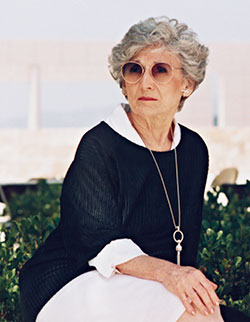Ada Louise Huxtable Archive
Ada Louise Huxtable papers, 1859–2013 (bulk 1954–2012)
Documenting the long and distinguished career of Ada Louise Huxtable (1921–2013), this archive is an essential addition to the Getty Research Institute's collections in the areas of modern architecture, urbanism, and related critical writing. Huxtable was the most important voice in architectural criticism over the last 50 years and stood at the beginning of the architectural preservation movement, championing the conservation of many important landmarks in New York and elsewhere in the country.
The archive contains a rich and diverse range of materials, comprising 93 boxes and 19 file drawers of Huxtable's manuscripts and typescripts, reports, correspondence, and documents, as well as research files full of notes, clippings, photocopies, and, most notably, original photographs of architecture and design by contemporary photographers such as Balthazar Korab and Ezra Stoller as well as her late husband, L. Garth Huxtable, an industrial designer whose archive was donated to the Getty Research Institute by Mrs. Huxtable. Of particular importance is her correspondence with architects containing intellectual exchanges about the practice of architecture, including a provocative interaction with Philip Johnson after Huxtable had written a rather negative review of his six-building PPG Place complex in Pittsburgh. Perhaps even more interesting is that in addition to the letters from Johnson himself, there are letters from architects Edmund Norwood Bacon, Peter D. Eisenman, and Richard Meier—all of whom would never have dared to say something negative to Johnson—telling Huxtable how much they agree with her critique and why. As the first dedicated architecture critic writing for a major newspaper, the New York Times, Huxtable's straightforward and accessible writing also made her a very popular critic among the general public, who sent appreciative responses and comments throughout her entire career. She received letters from other women impressed by the power of this relatively young, petite-looking woman's outspoken voice and her influence on what were then primarily male worlds of architecture, construction, and city politics. Containing files for all the books Huxtable authored, the archive will be an extremely important addition to the Research Institute's archives of other architecture writers such as Reyner Banham, Herbert Muschamp, and Nikolaus Pevsner. | ||||||

